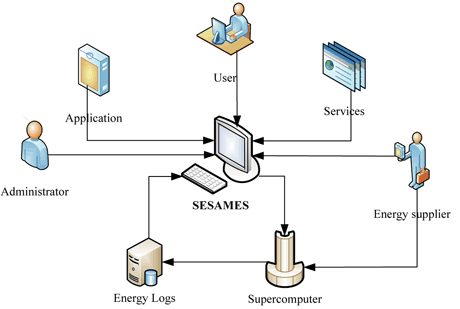by Mohammed el Mehdi Diouri, Olivier Glück and Laurent Lefèvre
A supercomputer is a system built from a collection of computers performing tasks in parallel in order to achieve very high performance. An exascale machine is a supercomputer capable of performing more than 1018 floating point operations per second (1 Eflop/s). Such extreme-scale systems are needed by 2018 in order to meet new scientific challenges, such as enabling highly sophisticated genome calculations and proposing individualized patient treatments. As they will gather hundreds of millions of cores, exascale supercomputers are expected to consume enormous amounts of energy (between 25 and 100 MW). In addition to being very large, their power consumption will be very irregular. Furthermore, the applications that will run on such extreme-scale systems will need energy consuming services such as fault tolerance, data collective operations. In order to manage the execution of extreme-scale applications on future supercomputers in a sustainable and energy-efficient way, we propose a framework called SESAMES: Smart and Energy-aware Service-oriented Application Manager at Extreme-Scale [1].
Since the power consumption of these large scale systems is enormous and dynamic, SESAMES establishes a permanent negotiation with the energy provider (Figure 1). Through this dialog, SESAMES gives the energy supplier an agenda of the estimated power consumption. It also gathers from the energy supplier the agenda for: energy price, energy sources used, and power capping. The price, energy source (coal, sun, wind etc) and threshold limit will vary at different times. Supercomputer users may prefer to consume energy at times when it is the cleanest and least expensive whilst energy providers may adapt the supply according to demand and may choose to disable some production of energy produced from a polluting source during times of low power use.

Figure 1: Global infrastructure: external interactions with SESAMES
Furthermore, in order to reduce global energy consumption, SESAMES is able to act directly on the supercomputer nodes. An energy sensor is plugged to each node and measures the current power consumption. SESAMES collects these energy logs. In order to gather the execution context, SESAMES also establishes a dialog with users of supercomputers. This interaction with the user occurs at the moment of reserving computing nodes and just before running applications and services (see Figure 1).
In order to run their applications, users send to SESAMES a reservation request to book some of the supercomputer's nodes. A reservation request consists of the number of nodes required, the reservation duration, the earliest possible start time and the latest possible start time. In order to make a reservation, SESAMES solves a multi-criteria optimization problem by taking into account several constraints. It attempts to allocate the supercomputing nodes at the time desired by the user by consuming the least amount of energy, the cleanest energy, at the lowest financial cost and without exceeding the power capped by the energy provider. If no solution exists, SESAMES informs the user that the requested reservation is not possible. If there exists a unique solution that optimizes all the criteria, SESAMES makes the corresponding reservation and informs the user about it. Otherwise, SESAMES computes the solutions that optimize each criterion separately and asks the user to choose between the solution that minimizes the financial cost or the one that provides the cleanest energy.
Once the reservation is done, SESAMES gives the user the opportunity to estimate and reduce the energy consumption of the different services (like fault tolerance) that he would like to run while executing his applications. For each service, several versions are possible. The least energy consuming version depends on the application’s features. Hence, the first step to consuming “less” energy is to choose the least energy consuming version for each service. Thanks to the interaction with the user, SESAMES takes into account the application features and the user requirements in order to provide an energy estimation of the different versions of the services requested by the user.
To reduce the energy consumption of supercomputers, SESAMES proposes to apply some green leverages at the component level: shutting down or slowing down an idle resource component (processor, memory, disk, etc.). The shutdown approach involves dynamically turning off unused resources and turning them back only when they are needed. The slowdown approach involves dynamically adjusting the performance level of a resource according to the performance level the application and users really need. The green leverages proposed depend on the idle periods predicted and on the rights assigned by the supercomputer administrator to the user. The energy consumption of these green solutions is estimated by SESAMES in order to make the user aware of the energy savings generated by the green solutions suggested.
Reference:
[1] M. Diouri, O. Gluck, and L. Lefevre: “Towards a novel Smart and Energy-Aware Service-Oriented Manager for Extreme-Scale applications”, First Workshop for Power Grid-Friendly Computing (PGFC'12), San Jose, USA, 2012.
Please contact:
Mohammed El Mehdi Diouri
Inria Avalon Team
ENS Lyon, Inria, LIP Laboratory, University of Lyon, France
Tel : +33472728009
E-mail:
http://perso.ens-lyon.fr/mehdi.diouri











